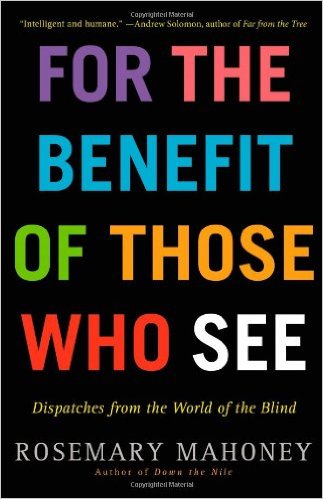It was a bleak Seattle winter morning several years ago, and I shivered as I climbed into the yellow taxi cab. I was dreading my appointment at the WA Department of Services for the Blind (DSB) for many reasons, but I had finally decided to see what kind of services might be helpful to me. They had sent me a voucher for the taxi ride, so that transportation to DSB would be direct and free.
I handed the voucher to the cab driver, and noticed him eyeing me suspiciously in the rear view mirror. I glanced down at the time on my phone to make sure I would be to my appointment on time. When I looked back up, I saw that he was once again glancing at me in the rear view mirror.
I instructed myself to stop being paranoid, and focused on checking Facebook updates on my phone for the remainder of the ride. As the driver pulled into the DSB parking lot, he asked in a thick Indian accent, “So, are you blind?”
I wasn’t expecting his question, so I paused briefly before saying, “Um…yes, I have a rare eye disease that is causing me to lose my sight.”
He did not say anything back to me, but shook his head from side to side, and made a “tisk, tisk tisk” sound, like he was tapping his tongue on the roof of his mouth. I instantly felt my face flush with embarrassment. I wasn’t sure if he was pitying me or shaming me. I was relieved to step out of the taxi and out of the driver’s seemingly judgmental presence. I didn’t give the incident further thought until recently when I read For the Benefit of Those Who See: Dispatches from the World of the Blind.
In this nonfiction book, author Rosemary Mahoney explores many topics affecting blind people, including prejudices around the world. As I read Mahoney’s stories, I recalled my taxi driver incident, and realized that this brief encounter was just a small glimpse into a world of bigotry that many blind people face everyday around the world. In the United States, blind people are often pitied, but rarely blamed for their blindness as Mahoney reports in many developing countries.
Mahoney provides vivid, enlightening descriptions of her interactions with blind students she meets at Braille Without Borders, first in Tibet and then in Kerala, India. She shares stories from her blind students in their own words.
”Where I lived in Germany, blind children were not allowed to go to normal kindergarten. I was sent to a boarding school when I was 3 years old. They beat me.”
“In Liberia, whenever a blind person passes by, they say now this person in front of me must be dealing in witchcraft. He moves like a man who can see, but he cannot see.”
“I could not go out and play with the other children, and was not let to do anything for myself. When I first came to Braille Without Borders, I was 12 and I didn’t know how to dress or wash myself already. I had no education….I always thought that blind people couldn’t do anything besides eat and sleep.”
There is so much that stands out to me in this detailed account of the world of the blind that it is hard to choose which aspects to focus on for this brief review. As a partially sighted person, I immediately took note of the way Mahoney describes her students that are newly blind or who retain some vision. She observes struggles in these students that do not exist within the general blind population of the school. She finds that these students are unable to embrace the darkness and observes how they cling to the sighted world.
Mahoney also explores the social history of blindness, a subject I found particularly fascinating. “Blindness, more than any other physical handicap, has been terrifying even the most intelligent and enlightened people since the beginning of time. The common negative reaction that the sighted have toward the blind is visceral, and the social status of millions of blind people has been decided more by sighted people’s emotional misprision of them than by any qualities or inabilities inherent in the blind person…..Traditionally, the blind have been seen and portrayed in one of three stereotypical ways, as mystical soothsayers endowed with supernatural and thus dangerous powers, as helpless ineducable idiots fit only for pity and mockery, or as vagrant beggars with base morals and uncanny gifts for cunning and deception. These portraits, which sometimes overlap, are confusing and even contradictory.”
While Mahoney’s extensive research on the topic of blindness is impressive, it is her descriptive accounts of the blind people she befriends that I find most engaging. At one point, she allows two of the blind students to lead her through Lhasa blindfolded. “Immediately, I had the sensation that the ground beneath my feet was tilting, sounds seemed to become louder, smells became stronger, and the breeze on my face felt more forceful and distracting. I tripped on a raised lip of pavement and the girls quickly tightened their grip on my elbows to keep me from falling…..I felt terribly vulnerable and had to fight the impulse to lift the blindfold off my face.” Mahoney goes on describe her heightened senses in detail as the two girls lead her successfully to the temple and then back to the school.
Mahoney’s vivid descriptions of Sabriye Tenberken, the founder of Braille Without Borders who also has Retinitis Pigmentosa, made me feel like I had met her in person myself. “Her eyes were striking. They were stark blue, clear, deep set and though they saw nothing at all, they were vibrant and healthy looking. When I spoke, she faced me directly and gazed with such focused concentration, she seemed to not just be seeing me but seeing through me. She didn’t look like a person who couldn’t see.”
I love the description of Sabriye’s confident stride and the way she linked arms with Mahoney, not so that she can be guided but to help guide the fully-sighted Mahoney on an errand to the center of the city. “A small break appeared in the two lanes of traffic rushing west, and at just the right moment Sabriye applied a light pressure to my arm and we plunged forward and crossed safely to the far side of the street. There, without breaking stride, she hopped nimbly over a knee-high barrier that separated the bicycle lane from the rest of the traffic and stepped up onto the sidewalk. She turned left at the next corner, where a woman selling dumplings from a bamboo pot stared at her in astonishment. I could hardly blame the woman, for I too was staring, mystified as to how Sabriye managed to navigate the world so swiftly and flawlessly.” She goes on to describe a girl on their route who pointed at Sabriye and yelled a Chinese phrase that means “here comes an idiot!” She describes how Sabriye held her head up high and said that no one can insult her with blindness because she is proud to be blind. Thanks to Rosemary Mahoney, Sabriye’s inspiring story, My Path Leads to Tibet, is next on my must read list.
I appreciated reading a book about blind people from a sighted person’s perspective, especially as her intention is clearly to educate the sighted on a topic many people fear. I recommend this book to anyone interested in gaining a broad yet detailed description of the blind and the human resilience we all possess.


It frustrates me so greatly to hear about the negative responses that some have to people with visual impairments. If they even knew 1 of the amazing people that I know who just happen to have a visual impairment, I can’t believe they would hold on to these views. I feel like I have such a complex relationship with sight (being sighted myself, but working with those who don’t). Sure, life is managed differently if you don’t have sight than if you do, but my life is certainly managed differently with kids than it was without kids. Jenelle, you and Joy are amazing PEOPLE. You’re also amazing women/mothers/friends and also people with visual impairments. I wish the world would wake up and see people as people, regardless of their differences.
What Kierstyn said! Plus, great book review, Jenelle. I appreciated how you incorporated your personal experiences with points in the book. I will be reading this book in the future.
Thanks Susan. I think you will really enjoy the book. There’s so much more to it that I did not even touch on, so it would be interesting to read a review on your blog from your perspective.
What a fantastic analogy, Kierstyn….yes, we do things differently without sight just like you do now that you have kids. It’s people like you, who work in the vision field and accept people for the capable individuals that they are, regardless of vision, that really help model how to interact and accept those who happen to have visual impairments. I got goosebumps reading your comment….thank you so much!
Oh yeah, great book review, Jenelle! It really gave me a good idea of what the book is about. I may get too angry to read it all, though I look forward to hearing your review of Sabriye’s My Path Leads to Tibet.
Kierstyn,
Thanks for your encouraging words. I love your last sentence especially….if only people could see people as people regardless of differences – that applies to so many areas of life – race, religion, disabilities, etc. Your patients are so lucky to have you as their doctor because you treat them as people, not just eyeballs to examine. And I’m so glad that you’re teaching the next generation of eye specialists. And most of all, I’m so glad that you’re my friend for over 20 years now! (damn,we’re old)
Jenelle
Well written. I am Pat Thomas’s brother in Ga and
Sometimes read the blog. Always enjoy the insight here
Sincerely,
Dan